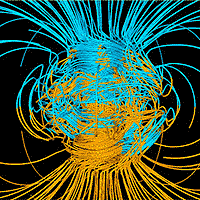Solar + Battery Car DIY STEM Kit
$11.99$6.50
Posted on: Apr 8, 2004

Image courtesy: Gary Glatzmaier, University of California, Santa Cruz and NASA/JPL.
The time it takes for Earth's magnetic field to reverse polarity is approximately 7000 years, but the time it takes for the reversal to occur is shorter at low latitudes than at high latitudes, a geologist funded by the National Science Foundation (NSF) has concluded. Brad Clement of Florida International University published his findings in this week's issue of the journal Nature. The results are a major step forward in scientists' understanding of how Earth’s magnetic field works.
The magnetic field has exhibited a frequent but dramatic variation at irregular times in the geologic past: it has completely changed direction. A compass needle, if one existed then, would have pointed not to the north geographic pole, but instead to the opposite direction. Such polarity reversals provide important clues to the nature of the processes that generate the magnetic field, said Clement.
Since the time of Albert Einstein, researchers have tried to nail down a firm time-frame during which reversals of Earth's magnetic field occur. Indeed, Einstein once wrote that one of the most important unsolved problems in physics centered around Earth's magnetic field. Our planet's magnetic field varies with time, indicating it is not a static or fixed feature. Instead, some active process works to maintain the field. That process is most likely a kind of dynamic action in which the flowing and convecting liquid iron in Earth's outer core generates the magnetic field, geologists believe.
Figuring out what happens as the field reverses polarity is difficult because reversals are rapid events, at least on geologic time scales. Finding sediments or lavas that record the field in the act of reversing is a challenge. In the past several years, however, new polarity transition records have been acquired in sediment cores obtained through the international Ocean Drilling Program, funded by NSF. These records make it possible to determine the major features of reversals, Clement said.
"It is generally accepted that during a reversal, the geomagnetic field decreases to about 10 percent of its full polarity value," said Clement. "After the field has weakened, the directions undergo a nearly 180 degree change, and then the field strengthens in the opposite polarity direction. A major uncertainty, however, has remained regarding how long this process takes. Although this is usually the first question people ask about reversals, scientists have been forced to answer with only a vague 'a few thousand years.'"
The reason for this uncertainty? Each published polarity transition reported a slightly different duration, from just under 1,000 years to 28,000 years.
"Now, through the innovative use of deep-ocean sediment cores, Clement has demonstrated that magnetic field reversal events occur within certain time-frames, regardless of the polarity of the reversal," said Carolyn Ruppel, program director in NSF's division of ocean sciences. "Sediment cores originally drilled to meet disparate scientific objectives have led to a result of global significance, which underscores the value of collecting and maintaining cores and associated data."
Clement examined the database of existing polarity transition records of the past four reversals. The overall average duration, he found, is 7,000 years. But the variation is not random, he said. Instead it alters with latitude. The directional change takes half as long at low-latitude sites as it does at mid- to high-latitude sites. "This dependence of duration on site latitude was surprising at first, but it’s exactly as would be predicted in geometric models of reversing fields," Clement said.
 'A scientist is happy, not in resting on his attainments but in the steady acquisition of fresh knowledge.'
'A scientist is happy, not in resting on his attainments but in the steady acquisition of fresh knowledge.'